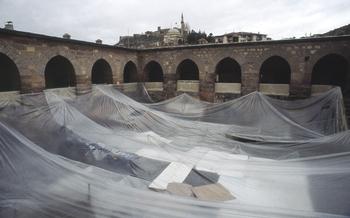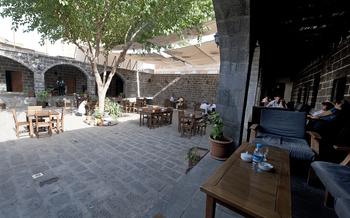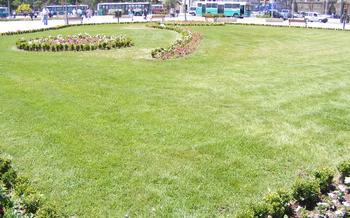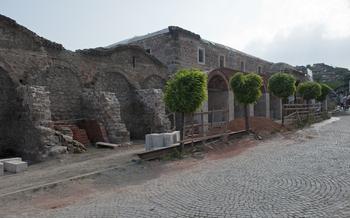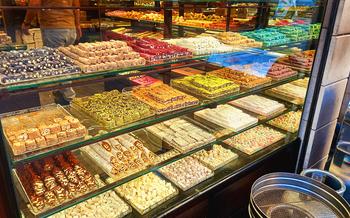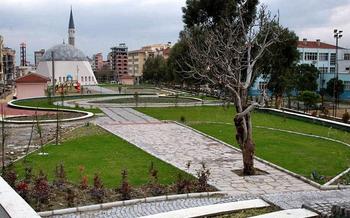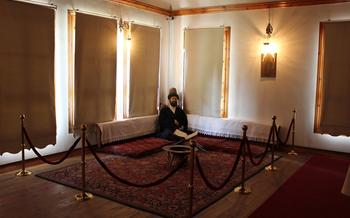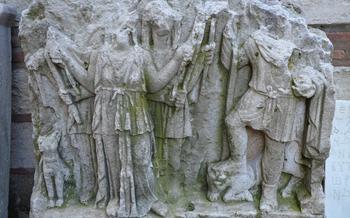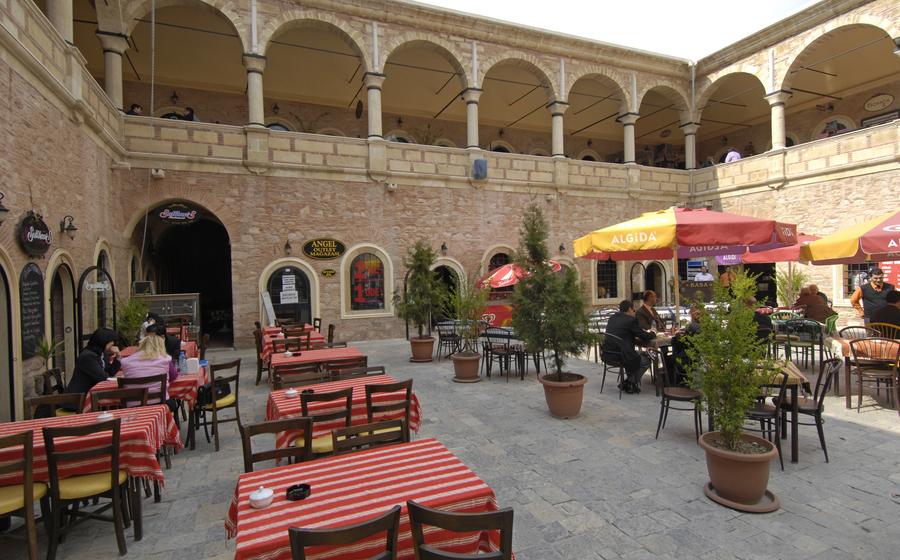
Kursunlu Han
- Historical Significance
- Architectural Marvel
- Location and Accessibility
- Admission and Timings
- Things to See and Do
- Shopping and Dining
- Photography Opportunities
- Cultural Significance
- Historical Context
- Architectural Details
- Local Customs and Traditions
- Off-the-Beaten-Path Experiences
- Family-Friendly Activities
- Sustainable Tourism
- Insider Tip:
Historical Significance
The Kursunlu Han, a testament to the rich history of Manisa, Turkey, stands as a proud reminder of its role as a resting place for weary traders and travelers traversing the ancient Silk Road. Built in the 14th century, this caravanserai, an iconic symbol of hospitality, played a pivotal role in facilitating trade and cultural exchange between East and West. Its strategic location along the trade routes and well-preserved state make it a living testament to the architectural prowess of the Seljuk and Ottoman empires. Explore the Kursunlu Han, immerse yourself in its stories, and discover the echoes of history that linger within its walls.
Architectural Marvel
The Kursunlu Han stands as a testament to the architectural prowess of its builders. The exterior of the han is adorned with impressive stonework and intricate carvings that showcase the artistic and cultural influences of the Seljuk and Ottoman empires. Step inside to admire the grand courtyard, surrounded by two-story galleries that create a sense of grandeur and symmetry. Notice the pointed arches, vaulted ceilings, and decorative niches that are characteristic of Seljuk architectural style. Explore the rooms and chambers that once housed traders and their goods, marveling at the well-preserved condition of this historic caravanserai. The Kursunlu Han is a true architectural gem that offers a glimpse into the rich history and cultural heritage of Turkey.
Location and Accessibility
The Kursunlu Han is conveniently nestled in the heart of Manisa, Turkey, inviting travelers to explore its rich history and architectural splendor. Reaching the han is a breeze, whether you choose to drive your own vehicle, hop on public transportation, or join a guided tour.
Driving: For those traveling by car, the Kursunlu Han is easily accessible via well-maintained roads. Simply follow the signs leading to the city center and you'll find yourself in the vicinity of this historical gem.
Public Transportation: If you prefer to leave the driving to someone else, Manisa's efficient public transportation system has you covered. Buses and trams regularly stop near the Kursunlu Han, making it a hassle-free option for getting around.
Guided Tours: For a more immersive experience, consider joining a guided tour that includes a visit to the Kursunlu Han. These tours often provide insightful commentary and anecdotes, bringing the history of the han to life.
Situated within walking distance of other notable attractions and historical sites, the Kursunlu Han is an ideal starting point for exploring the captivating city of Manisa. Immerse yourself in the rich cultural tapestry of this vibrant city, where history intertwines with modern-day charm.
Admission and Timings
Visiting the Kursunlu Han is a relatively affordable experience, with entrance fees being minimal or nonexistent. The han is open to the public during daylight hours, typically from 9 am to 5 pm. However, it is advisable to check for any seasonal variations or special events that may affect the opening times. To make the most of your visit, try to avoid peak tourist hours, which usually fall around midday. Instead, consider visiting early in the morning or late in the afternoon to enjoy a more peaceful and intimate experience. Guided tours are available for a more immersive experience, and it is recommended to book in advance to secure your spot. These tours often provide valuable insights into the history, architecture, and cultural significance of the han.
Things to See and Do
A visit to the Kursunlu Han offers a rich blend of history, culture, and interactive experiences. Explore the various exhibits and displays that showcase the history and significance of this ancient caravanserai. Learn about the architectural features, trading routes, and the role of the han in facilitating cultural exchange along the Silk Road. Interactive activities and educational programs are often available for visitors, especially children, providing a fun and engaging way to delve deeper into the han's past. The han also hosts cultural events, workshops, and festivals throughout the year, offering visitors a chance to immerse themselves in Turkish traditions and customs. Don't miss the opportunity to explore the surrounding area, where you can discover additional attractions and points of interest that will further enrich your understanding of Manisa's rich cultural heritage.
Shopping and Dining
Within the walls of the Kursunlu Han, a vibrant marketplace awaits visitors. Local shops and bazaars line the cobblestone streets, offering an array of traditional handicrafts, souvenirs, and regional delicacies. The air is filled with the scent of spices, freshly baked bread, and Turkish coffee, enticing visitors to indulge in the local flavors.
For a truly immersive culinary experience, step into one of the restaurants or cafes nestled within the han's premises. Here, you can savor the delights of traditional Turkish cuisine, prepared with fresh, local ingredients and served in a setting that oozes history and charm. Imagine enjoying a hearty kebab or a steaming bowl of lentil soup surrounded by centuries-old architecture, transporting you back in time.
As you explore the market, be sure to engage with the friendly vendors who are always eager to share stories about their products and the local culture. Bargaining is a customary part of the shopping experience in Turkey, so don't be afraid to haggle for the best prices. With a bit of patience and a smile, you're sure to find unique and authentic souvenirs to cherish your visit to the Kursunlu Han.
Photography Opportunities
The Kursunlu Han offers a treasure trove of photographic opportunities for enthusiasts of all skill levels. Capture the grandeur of the courtyard, with its towering arches and intricate carvings, as the sunlight casts dramatic shadows across the stonework. Explore the two-story galleries, discovering hidden corners and details that tell stories of a bygone era. Experiment with different angles to showcase the han's architectural beauty, from sweeping panoramas to close-ups of decorative elements.
Plan your visit to coincide with sunrise or sunset to capture the most favorable lighting conditions. The golden hues of dawn and dusk bathe the han in a warm glow, creating a magical atmosphere for your photographs. Consider using filters or editing techniques to enhance the colors and contrast of your shots, bringing out the vibrant details of the han's architecture. Share your best captures with fellow travelers and photography enthusiasts, inspiring them to embark on their own journey to this remarkable historical gem.
Cultural Significance
The Kursunlu Han holds immense cultural significance as a symbol of Turkish heritage and hospitality. For centuries, it served as a social and economic hub, fostering cultural exchange and trade between diverse communities along the Silk Road. Its strategic location facilitated the mingling of ideas, traditions, and customs, contributing to the rich cultural tapestry of the region. The han's enduring legacy as a place of welcome and interaction has earned it a special place in the hearts of locals and travelers alike.
Throughout its history, the Kursunlu Han has witnessed countless stories of human connection and cultural exchange. Merchants from distant lands would gather within its walls, sharing tales of their travels and showcasing their goods. Local artisans displayed their skills, creating beautiful handicrafts that blended traditional techniques with foreign influences. The han's vibrant atmosphere fostered a sense of community and understanding among people from different backgrounds, promoting peace and harmony in the region.
Today, the Kursunlu Han stands as a testament to the enduring power of cultural heritage. Ongoing efforts to preserve and restore the han ensure that its legacy will continue to inspire future generations. Visitors to the han can immerse themselves in its rich history, appreciate its architectural beauty, and gain a deeper understanding of the cultural significance of this remarkable place.
Historical Context
The Kursunlu Han was built during a pivotal period in history, when the Silk Road served as a vital artery for trade and cultural exchange between East and West. This ancient network of trade routes spanned vast distances, connecting diverse civilizations and facilitating the flow of goods, ideas, and technologies.
The Seljuk and Ottoman Empires played a profound role in shaping the historical context of the Kursunlu Han. The Seljuks, a powerful dynasty of Turkic origin, ruled over a vast territory stretching from Central Asia to Anatolia during the 11th and 12th centuries. Their architectural legacy is characterized by the use of pointed arches, vaulted ceilings, and intricate tilework, which can be seen in the design of the Kursunlu Han.
The Ottomans, who succeeded the Seljuks, ruled over a vast empire for over six centuries, leaving an indelible mark on the region's history and culture. Their architectural style, which blended elements from Seljuk, Byzantine, and Islamic traditions, is evident in the later additions and modifications made to the Kursunlu Han.
Understanding this historical context is crucial for appreciating the significance of the Kursunlu Han. It was not merely a caravanserai but a testament to the vibrant cultural exchange and economic activity that flourished along the Silk Road, leaving a lasting legacy that continues to captivate visitors to this day.
Architectural Details
The Kursunlu Han boasts a captivating blend of Seljuk and Ottoman architectural styles, showcasing unique features that reflect the rich history of the region. The pointed arches, a hallmark of Islamic architecture, create a sense of grandeur and symmetry throughout the han. The vaulted ceilings, supported by sturdy pillars, add a touch of elegance and spaciousness to the interior spaces. Decorative niches, adorned with intricate carvings and patterns, provide visual interest and depth to the walls. These architectural elements, combined with the use of traditional materials like stone and brick, create a harmonious and visually stunning ensemble that transports visitors back in time.
Local Customs and Traditions
The Kursunlu Han and its surroundings are steeped in rich local customs and traditions that reflect Turkish hospitality and cultural heritage. When visiting the han, it is essential to be respectful of these customs to ensure a positive and meaningful experience.
Greetings in Turkey typically involve a handshake accompanied by a warm smile and eye contact. Showing respect for elders and authority figures is highly valued, so addressing them politely using formal titles is customary. When entering a mosque or other religious site, removing shoes and dressing modestly is expected as a sign of reverence.
In Turkish culture, hospitality is paramount, and guests are welcomed with open arms. Accepting a cup of tea or coffee offered by locals is considered a gesture of friendship and respect. It is also customary to bargain politely when shopping at local bazaars, as it is seen as a way to connect and build relationships with vendors.
To fully immerse yourself in the local customs, consider trying traditional Turkish cuisine, which is renowned for its rich flavors and variety. Mezze platters, succulent kebabs, and aromatic Turkish coffee are must-try delicacies. Participating in cultural events, such as traditional dance performances or music concerts, is another fantastic way to experience the vibrant local culture.
Off-the-Beaten-Path Experiences
Beyond the main attractions of the Kursunlu Han, there are hidden gems waiting to be discovered. Venture into the lesser-known courtyards and climb to the rooftops to capture panoramic views of the city and the surrounding landscape. Take a leisurely stroll through the adjacent neighborhood, where you'll find charming local shops, cozy cafes, and hidden culinary treasures.
For a unique experience, immerse yourself in traditional Turkish culture by visiting a nearby Turkish bath or "hammam." Indulge in a rejuvenating steam bath, followed by a massage and a refreshing scrub. Alternatively, sign up for a cooking class and learn the art of preparing authentic Turkish dishes using fresh, local ingredients.
Step off the beaten path and explore the authentic side of Manisa, where you'll encounter warm hospitality and discover hidden gems that will leave you with lasting memories. Embrace the opportunity to connect with locals, savor delicious cuisine, and create your own unique travel story.
Family-Friendly Activities
The Kursunlu Han offers a range of activities and attractions that cater to families with children. Guided tours are available, providing interactive and educational experiences tailored to younger visitors. These tours bring the history of the han to life, engaging children with storytelling and hands-on activities.
The surrounding area also offers family-friendly attractions. Manisa Zoo, located a short distance from the han, is a popular destination for families with its diverse collection of animals and interactive exhibits. The Manisa Museum of Natural History is another great option, showcasing the region's rich biodiversity through interactive displays and educational programs.
To keep children entertained during your visit, consider exploring the hidden courtyards of the han, where they can run and play freely. The nearby park, with its playground and green spaces, is another great option for families to relax and unwind.
Remember to pack snacks and drinks for your children, as there are limited food options available within the han. With its family-friendly atmosphere and range of activities, the Kursunlu Han promises a memorable experience for visitors of all ages.
Sustainable Tourism
As a responsible traveler, it's essential to practice sustainable tourism when visiting the Kursunlu Han and the surrounding area. Here are some tips to minimize your environmental impact and support the local community:
-
Opt for public transportation or walking: Reduce your carbon footprint by using public transportation or walking to get to the Kursunlu Han. Manisa has a well-connected public transportation system, making it easy to explore the city without a car.
-
Support local businesses: Contribute to the local economy by purchasing souvenirs, handicrafts, and food from local vendors and shops within the Kursunlu Han. This helps sustain traditional crafts and supports the livelihoods of local artisans.
-
Reduce waste: Be mindful of your waste production and properly dispose of trash in designated bins. Avoid single-use plastics and opt for reusable alternatives, such as water bottles and shopping bags.
-
Respect the environment: Show respect for the natural environment by avoiding littering, damaging plants, or disturbing wildlife. Follow designated trails and paths to minimize your impact on the delicate ecosystem.
Insider Tip:
For an unforgettable experience, plan your visit to the Kursunlu Han during the annual Silk Road Festival. This vibrant event brings the han's history to life with traditional music, dance performances, and artisans demonstrating their skills. Immerse yourself in the sights, sounds, and flavors of the Silk Road as you wander through the bustling courtyards and bazaars. Don't miss the opportunity to sample delicious Turkish cuisine, shop for unique handicrafts, and interact with local artisans who proudly showcase their heritage.
